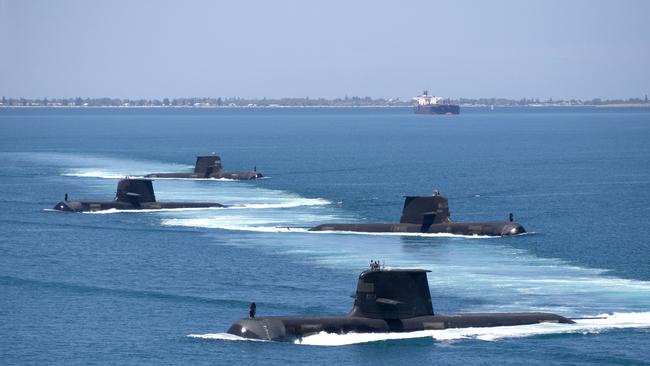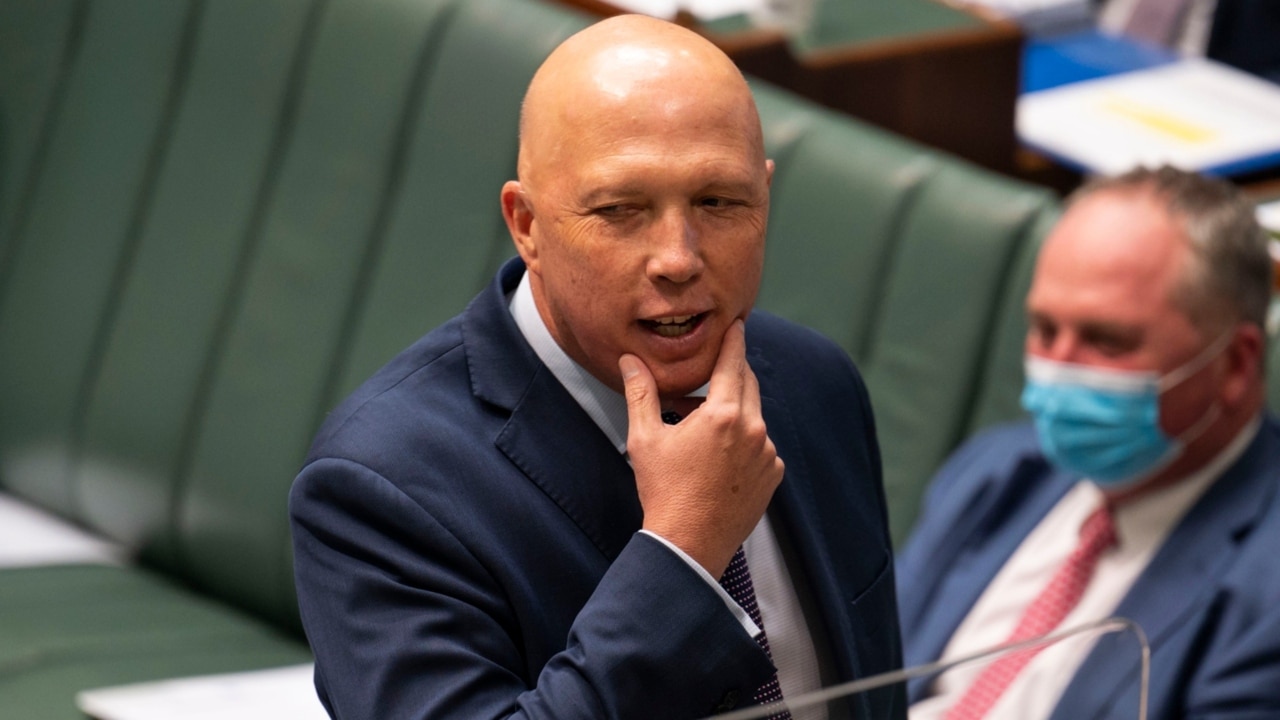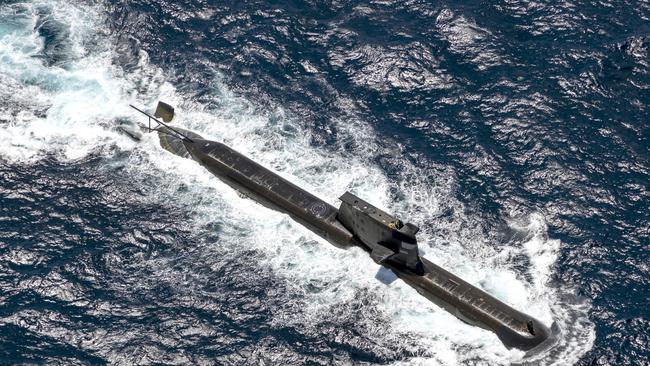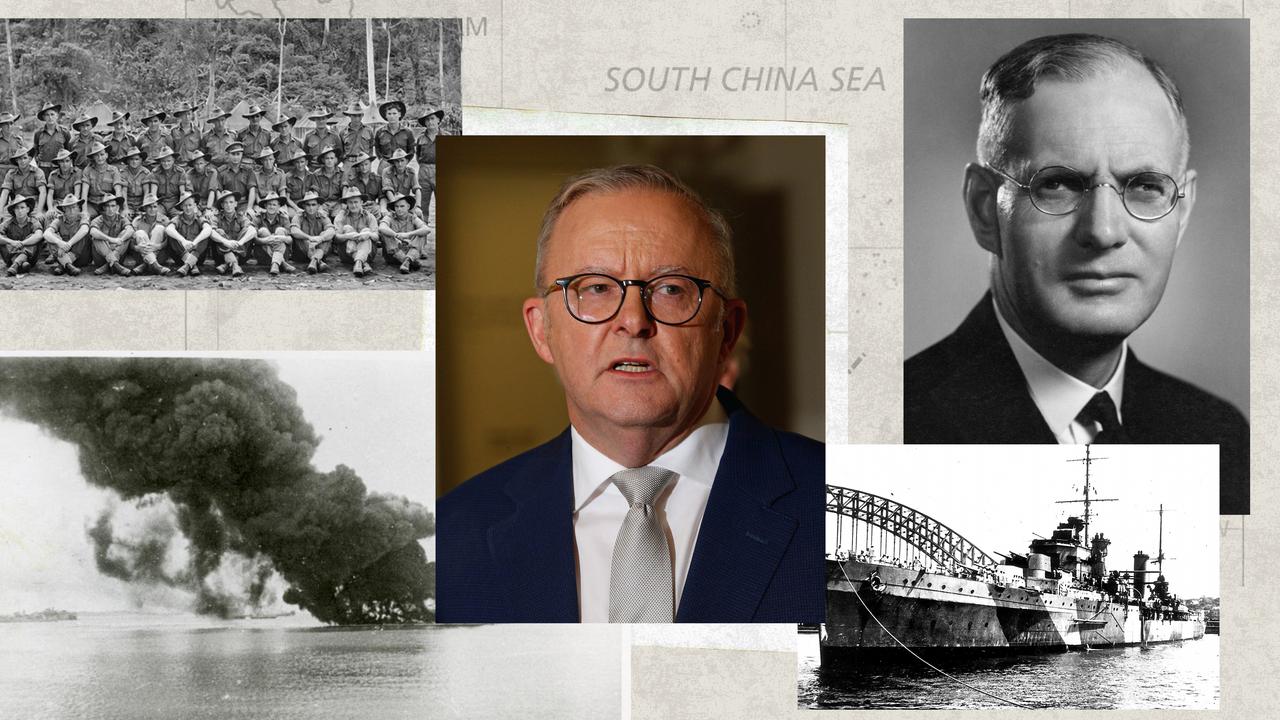It’s sink or swim as Labor sets the course for a refreshed fleet
Of all the decisions facing the Albanese government, none is larger than this. Defence Minister Richard Marles will have a baptism of fire in his new portfolio.

With such huge amounts of money at stake, the choices Marles makes on submarines and frigates will have a generational impact on taxpayers, federal budgets and national defence.
The good news for Marles is, as the new minister in a new government, he starts with a clean slate. He doesn’t have to defend the numerous mistakes and miscalculations on submarines that have been committed by successive governments of both sides of politics since 2009. He also doesn’t have to play by the rules and claims made by former defence minister Peter Dutton on what was possible and not possible with these two mega-projects.
The bad news is Marles faces a series of diabolic dilemmas on submarines and frigates for which there are no easy or perfect answers.
Marles is already receiving a blizzard of often-contradictory advice from defence chiefs, industry groups, retired admirals and even the Pentagon, each of which will want to influence the choices he makes. He also has suffered a well-directed torpedo from Dutton, who claimed this week that Marles was flirting with a “very dangerous” decision to order new conventionally powered submarines ahead of the arrival of the planned nuclear-powered fleet.
Marles’s dilemma on submarines boils down to the simple mathematical problem that the nation’s existing fleet of six ageing Collins-class submarines will be all but obsolete by the time Australia is scheduled to acquire the first of its eight nuclear-powered boats.
Marles has firmly recommitted the Albanese government to the AUKUS trilateral security pact between Australia, Britain and the US, including its central mission of obtaining a nuclear-powered submarine fleet.
But the problem with the six Collins-class submarines is that after undergoing a 10-year life of type extension from 2026 they will retire from service progressively every two years from 2038.

By 2040 – about the time the first nuclear-powered boat is supposed to enter service – there will be only four Collins-class boats left in the water.
But by then those remaining original Collins submarines will be more than 40 years old and are unlikely to be fit for any serious operational activity and certainly not combat. They will be ornamental at best, in the same way that the RAAF’s F-111 strike bomber could not be sent to war in its final years because of its age.
So even if the first nuclear-powered boat arrived in 2040, the navy’s submarine fleet would already be effectively obsolete.
But the previous government’s assumption that Australia would have a nuclear-powered boat in the water as early as 2040 was also a heroic one. Not a single serious strategic expert outside of the Department of Defence believes Australia – with no history of building, operating or understanding nuclear-powered submarines – can build one here on time and within 20 years.
Dutton claimed this week that he believed he could have negotiated with the Americans to deliver two US-built Virginia-class nuclear-powered submarines by 2030, ruling out the need for interim conventional submarines.
His claim left many questions unanswered. Even if such a deal could be reached between the two countries, could the US Navy squeeze two Australian submarines out of a production line in the US that was already full and behind schedule? How would Australia crew and captain the boats at such short notice with no nuclear-trained crews?
Marles says the submarine timelines offered by the navy and the Morrison government have been fanciful and no nuclear submarine is likely to arrive before the mid-2040s. He has said that solving the looming capability gap would be “pretty well the No.1 agenda item in this portfolio”.
“I don’t for a second pretend this is not going to be a really difficult issue. It is. And I don’t have all the answers right now on day one, but this is a key focus.”
So what are Marles’s options?
Potential non-submarine options that have been floated publicly include buying B-21 bombers, undersea drones, long-range missiles or building more Hobart-class air warfare destroyers on top of the three the navy already has. While any of these options would improve Australia’s overall defence, it won’t help sustain the submarine fleet.
A more likely option is that Marles will order interim conventional submarines to supplement the Collins-class boats and maintain an effective submarine capability until the nuclear-powered boats arrive. Marles has hinted that he favours this option.
But if he does order more conventional submarines, would they be based on exportable designs from countries such as Germany, or some sort of evolved version of the existing Collins-class boats?
Dutton and the navy argued against building more conventional submarines on the grounds that it would create a “third class” of submarine, which was too much for the navy to handle.
“Introducing an interim submarine I think would bring more

Challenges than capability,” Chief of Navy Michael Noonan said last month. “It would seem inconceivable that a small navy such as ours could viably operate a transition of Collins to an interim to a nuclear.”
Asia-Pacific Defence Reporter magazine editor Kym Bergmann says such claims are unconvincing. He points out that other countries in the region, including Japan and South Korea, “simultaneously operate at least three different classes without apparent difficulty”.
“The situation is crying out for more conventional submarines and fast,” he writes. “It is estimated that by 2030 China will operate around 60 modern diesel electric submarines as well as a dozen huge ballistic missile-firing SSBNs.”
Within the navy, some senior officers fear that any decision to build new conventional submarines will push the timetable for acquiring nuclear submarines into the never-never.
The Morrison government also was opposed to the idea, in part because it would have raised the difficult political question of why it cancelled the French contract to build conventional submarines, only to turn around and order more conventional boats.
But the new Defence Minister is not constrained by the politics of the AUKUS decision. If he were to order more conventional submarines as a stopgap before the arrival of the nuclear-powered fleet, some experts believe Australia could have new submarines in operation as early as 2032, a decade before the first nuclear-powered boat arrives.
Although some experts believe Australia should source proven designs for a new conventional boat from countries such as Germany, South Korea or Japan, the more likely option given the time constraints is that Marles will order a new batch of updated Collins-class submarines.
Retired rear admiral Peter Briggs believes the only way forward is to avoid any new design and instead build more Collins boats using their existing design while installing as many updated features as possible.
“There should be an immediate decision to build at least three further Collins-class submarines,” he tells Inquirer.
“The driving priority is time because we have lost so many years. We need to get cracking and we need to stick with the Collins because it will be quicker, we already have the design done.”
Critics of this idea say that by building more Collins-class submarines, you are simply reproducing a boat that was designed in the 1980s rather than a more modern and formidable submarine.

In 2012 the Defence Department investigated the feasibility of building a much more advanced new-generation version of Collins, dubbed a “son of Collins” or an “evolved Collins”.
But it scrapped the idea, concluding it would amount to a completely new design and therefore a new submarine. Yet there may be a middle ground between a new design for Collins and a replica of the existing boats. This solution would mean the navy did not have a grapple with a so-called “third class” of submarine.
Swedish submarine manufacturer Saab Kockums, which built the Collins, is offering a “Block 2” Collins-class that it says would be a completely new Collins submarine with a new hull and full modern upgrades while remaining true to the existing Collins design parameters. In other words, it would not require a new design but the boat still would last another 30 years if needed, removing any danger of a capability gap between the Collins and the nuclear-powered submarines.
To pursue this option would require Defence to engage Saab in a major way, something it strangely has refused to do so far.
Outgoing senator and former submariner Rex Patrick believes the government should scrap the notion of nuclear-powered submarines altogether because of the high price and focus instead on building new simpler, smaller conventional submarines based on proven European designs.
“There is no way that the Labor Party can justify spending $170bn on eight nuclear submarines when it is possible to obtain 20 off-the-shelf submarines for about $20bn,” he says. But Labor is unlikely to walk away from AUKUS.
In addition to deciding whether to acquire new conventional submarines, Marles will need to make the key decision on which nuclear-powered submarines Australia should choose – the latest version of Britain’s Astute-class or the US Virginia-class.
The Virginia-class is the most likely option for reasons that Dutton pointed out this week – it is capable of launching missiles vertically, it is a mature design that is already sailing and it is operated by our most important ally.
The 18-month review of the nuclear-powered submarine options is due early next year. It will address not only the choice of submarine but also whether they should be built overseas or in Australia, or even a hybrid of the two.

Marles also will need to consider how he will ramp up the submariner workforce from its current 900 to about 2500 and train this new workforce to operate and maintain nuclear-powered boats.
The second major naval headache facing the new Defence Minister is the future of the $45bn project to build nine Hunter-class frigates, the mainstay of the navy’s future fleet. The first ship already has been delayed by 18 months and the project’s cost has been adjusted up from $35bn to $45bn.
But the fundamental problem is that the decision of the Turnbull government in 2018 to choose the highest risk option for the future frigates has backfired. In that year the government selected the British Type 26 Global Combat Ship with significant Australian modifications.
Unlike the two other competitors in the tender – an Italian Fincantieri FREMM and a Spanish Navantia F-5000 – the British option was the only one that was not already based on an existing ship currently in service and was therefore the highest risk option.
Since then the development in Britain of the Type 26 frigate for its own Royal Navy has been delayed by design and weight issues, the consequences of which have flowed to the Australian program.
The Australian version of the Hunter-class has become even heavier because of Australian modifications including the radar, the combat system and all the weapons. The vessel’s weight margin – the margin of growth to place future systems on the warship – is believed to be only 270 tonnes or 3.3 per cent. This is considered by many experts to be too small to upgrade the ships with modern weapons and other systems as they evolve.
Dutton was so alarmed by the problems with the frigate program that he considered ripping up the contract just like with the French submarine deal. But he eventually concluded the contract was too difficult to abandon.
Politics may have played a part in his decision given Dutton was heavily involved in the creation of the AUKUS pact of which Britain is a key partner. It would have been difficult politically to scrap a giant British shipbuilding project while entering into a closer strategic partnership with London on submarines.
Marles also may face a diplomatic dilemma here. Australia would deliver a double black-eye to Britain if it scrapped the British frigate program and chose a US nuclear-powered submarine over the British option.
Labor colleague Brendan O’Connor, when he was opposition defence spokesman, said his inclination with the frigates was “to fix any problems with an existing contract … and get on with the job of delivering the assets rather than making decisions to cancel”.
But the view from opposition looks very different from the view in government when it comes to defence.
Marles is receiving a raft of classified briefings that will give him a much more informed view about the strategic challenges posed by China as well as a clearer view about the realities and challenges of the nuclear-powered submarines, the Collins-class submarines and the Hunter-class frigates.
Labor has rightly left all options open on these key decisions. But the gravity of the moment should not be underestimated. The defence portfolio has been littered with ministers who failed to take hard decisions.
Marles does not have that choice with the submarines or frigates. He has to make decisions quickly that will reverberate for a generation.




Of all the decisions facing the Albanese government there is none larger than the $215bn dilemma about how to proceed with the navy’s future submarines and frigates. Defence Minister Richard Marles will have a baptism of fire in his new portfolio. He will have to make key decisions quickly on the two biggest projects in the nation’s history.